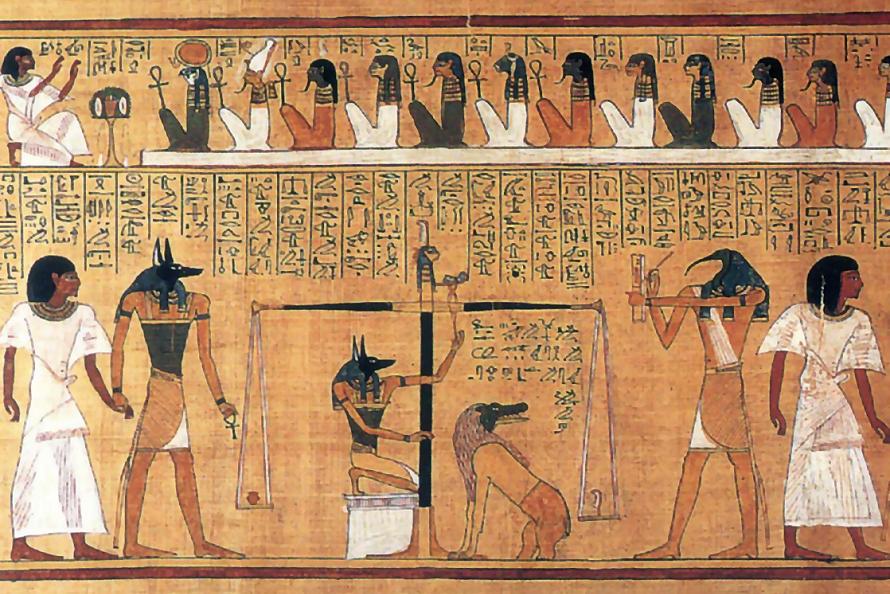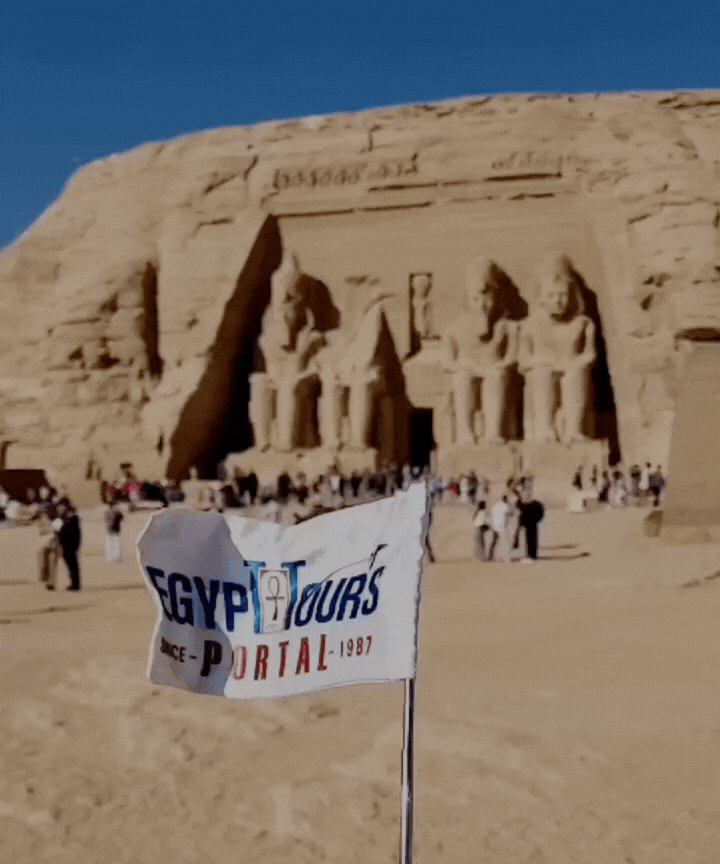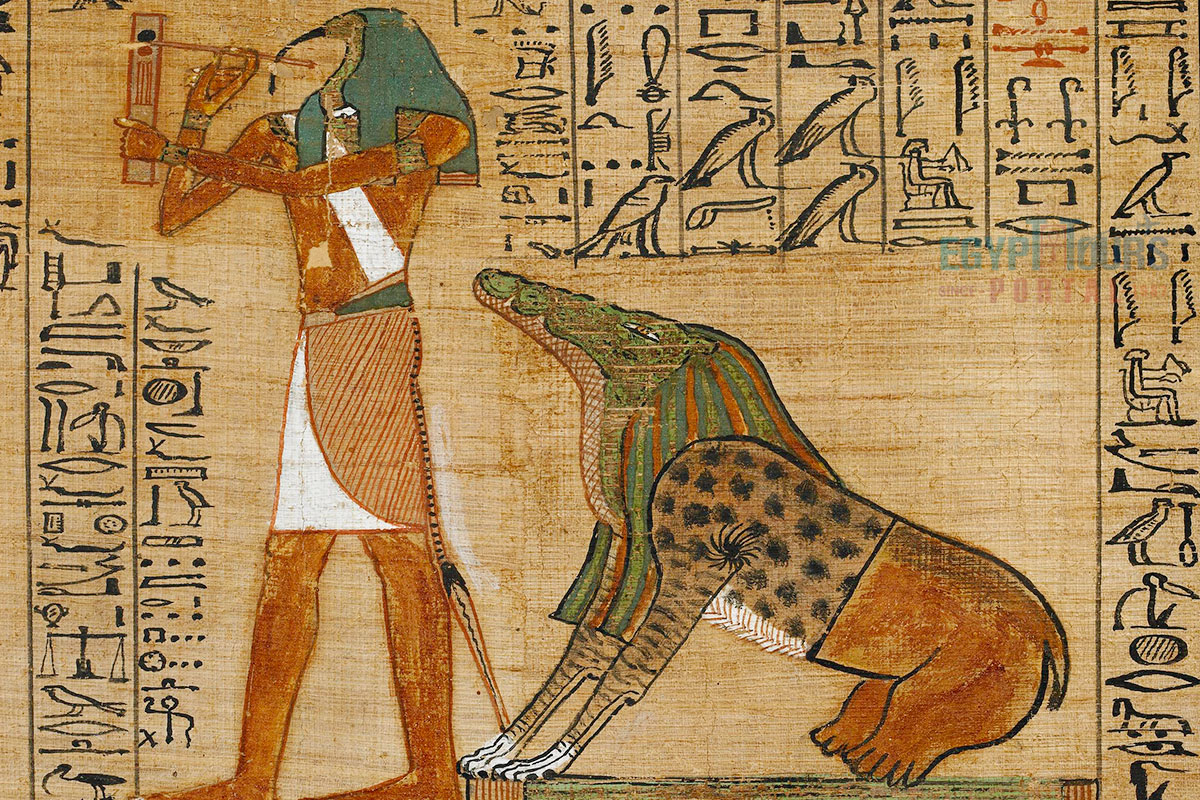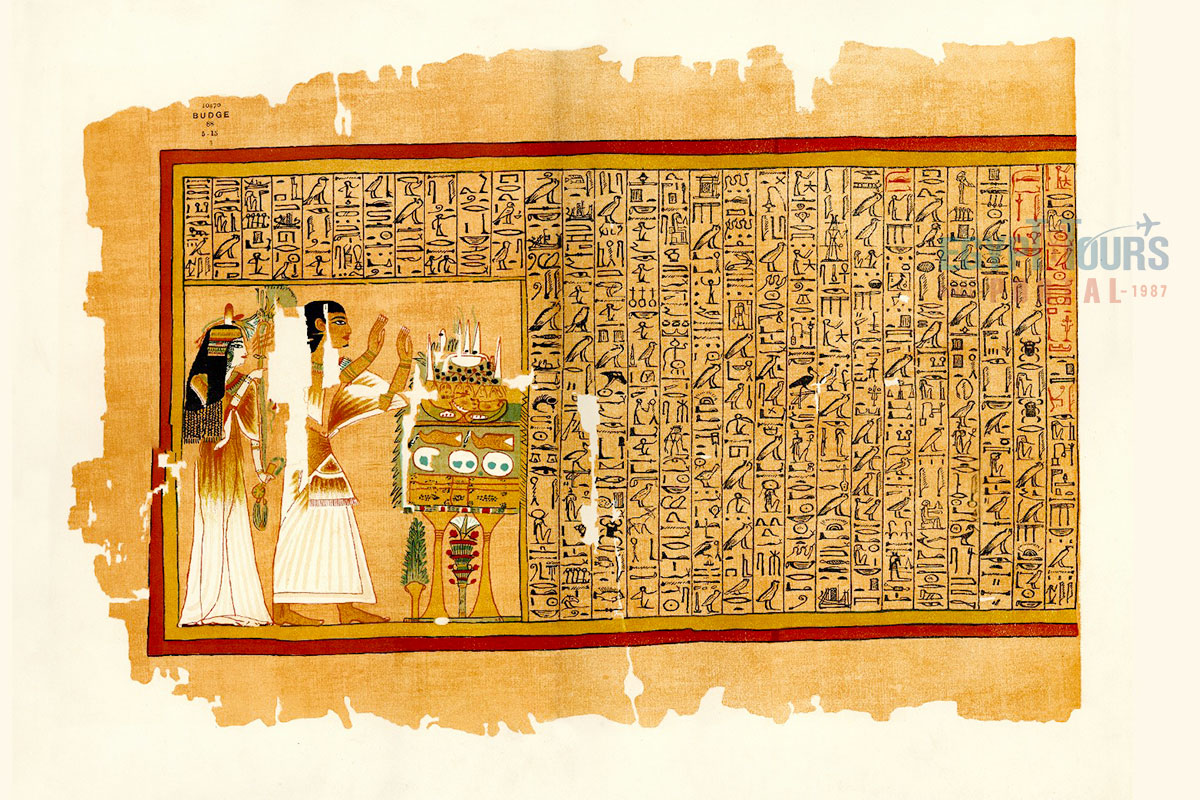Ancient Egyptian afterlife mythology centers on the soul's journey through the underworld, guided by gods like Anubis, and judged by Osiris. Righteous souls reach the Field of Reeds, a paradise. The concept of Ma'at, or cosmic order, emphasized the importance of living a virtuous life. Sacred texts like the Pyramid Texts and the Book of the Dead helped guide the deceased, shaping Egyptian burial practices, rituals, and societal values.


Afterlife in ancient Egyptian mythology reflects a profound belief system that intricately intertwines life, death, and the quest for immortality. For the Ancient Egyptians, earthly existence was merely one phase in a larger cosmic journey. Central to their worldview was the idea of a continued life after death, achieved through a complex series of rituals, moral adherence, and divine judgment. This belief system shaped Egyptian culture, influencing their burial practices, religious texts, and societal values.
The Egyptians held that the soul was immortal and composed of nine distinct parts, each contributing to the individual’s essence during life and beyond. These parts included the Ren (name), which carried identity; the Ka (vital essence), representing life force; and the Ib (heart), regarded as the seat of morality. Upon death, the soul transitioned into the Akh, or transformed self, to begin its journey to the afterlife. This journey required the guidance of deities, preparation through rituals like mummification, and ultimately, the judgment of the soul in the Hall of Truth.
IMPORTANT NOTE:
This information does not seek to degrade or insult any religion. All the information is based on historical evidence; any similarities that you may find with your faith or religion are from the figment of your imagination.

In Egyptian mythology, death marked the start of a perilous journey through the Duat, or the underworld, a realm governed by Osiris, the god of the dead. This journey was not undertaken alone; Anubis, the jackal-headed god of embalming and protector of the dead, served as the guide. He led the deceased from their tomb into the underworld and prepared them for the challenges ahead. The ultimate destination for a worthy soul was the Field of Reeds (Sekhet-Aaru), a paradise of eternal joy where the deceased could live in harmony.
The deceased’s body played an essential role in this journey, as the Egyptians believed that preserving the physical form allowed the soul to reconnect with it if necessary. This belief led to the practice of mummification, a meticulous process aimed at safeguarding the Khat (body) from decay. Mummification included wrapping the body in linen, placing protective amulets like the heart scarab, and adorning the deceased with ancient Egyptian symbols of purity, such as white garments. These measures ensured the body was ready for the trials of the Duat and could host the soul for eternity.

The judgment of the deceased in the Hall of Truth was a central aspect of Egyptian afterlife beliefs. This process determined whether a soul was worthy of immortality or condemned to oblivion. Upon reaching the Hall, the deceased stood before Osiris, the ruler of the underworld, who presided over the ceremony. Flanking him were the forty-two judges, divine beings who evaluated the soul’s righteousness. The Goddess Ma’at, embodying truth and balance, was also present, symbolized by her white feather of justice.
At the heart of the judgment ritual was the weighing of the heart. The deceased’s Ib (heart), believed to contain the essence of their soul, was placed on a golden scale opposite Ma’at’s feather. If the heart was lighter than the feather, it signified a life lived by truth, and the soul was declared pure. In such cases, Thoth, the god of wisdom and writing, recorded the favorable outcome, and the soul was granted access to the Field of Reeds. However, if the heart was heavier, weighed down by sin, it was cast to Ammut, the devourer of the unworthy.
Explore the power of Ma'at across all aspects of the ancient Egyptian civilization
Read More
Ammut, a monstrous figure with the head of a crocodile, body of a lion, and hindquarters of a hippopotamus, represented ultimate annihilation. For those whose hearts failed the test, Ammut consumed their souls, erasing their existence. This punishment ensured that the unjust could never enter the afterlife or disrupt the cosmic order. The fear of Ammut emphasized the importance of living a virtuous life, guided by the principles of Ma’at of truth and justice.

For the souls deemed worthy, the Field of Reeds (Sekhet-Aaru) awaited as a reward. This paradise mirrored an idealized version of life on Earth, complete with fertile lands, flowing rivers, and abundant resources. The deceased could reunite with loved ones, engage in activities they enjoyed, and partake in the divine blessings of the gods. Sekhet-Aaru was a land of perfection, free from suffering, where the soul could live in eternal harmony.
Reaching Sekhet-Aaru was not easy, as the journey through the Duat was fraught with challenges. The deceased had to pass through gates guarded by fierce ancient Egyptian deities and navigate perilous lakes of fire. Sacred texts, such as the Book of the Dead, provided the deceased with spells, maps, and passwords to overcome these obstacles. These texts were often inscribed on tomb walls or written on papyrus and placed alongside the deceased in their burial chamber.

The journey of the deceased was closely linked to the celestial cycle of Ra, the sun god. Each night, Ra traveled through the underworld, overcoming darkness and chaos to rise anew at dawn. The Egyptians believed that the deceased mirrored this journey, traveling with Ra’s solar barque through the Duat toward rebirth. For the righteous, this passage symbolized renewal and the triumph of light over darkness.
The deceased often relied on symbolic vessels, such as the Ship of Ra, to navigate the underworld. Model boats were frequently placed in tombs to aid this journey. For those who could not journey by boat, the coffin itself served as a symbolic womb, connecting the deceased with Nut, the sky goddess, and ensuring their safe passage to the afterlife.

The Egyptian belief in the afterlife was deeply rooted in morality and cosmic balance. Living a virtuous life, adhering to Ma’at’s principles, and performing rituals from ancient Egyptian religion were crucial for securing a favorable judgment. This emphasis on righteousness extended to burial practices, where offerings of ancient Egyptian food, clothing, and valuables were placed in tombs to sustain the deceased in the afterlife. These rituals also reflected the collective responsibility of the living to ensure the deceased’s successful journey.

To navigate the afterlife, the Egyptians relied on an evolving body of funerary ancient Egyptian texts:
These texts detailed the challenges of the Duat, offering wisdom and protection for the soul as it sought immortality.
The ancient Egyptians’ belief in the afterlife reflects their deep understanding of morality, spirituality, and the cosmic order. Their vision of death as a transformative journey, governed by divine judgment and celestial harmony, offers a timeless perspective on the human quest for meaning and eternity. Through their rituals, texts, and monumental tombs, they sought not only to secure their immortality but to leave a legacy that continues to captivate and inspire the modern world.
If you have a passion to explore Ancient Egyptian history, then you can experience our Egypt vacations and Nile Cruises to enjoy & listen to the mysterious story about ancient Egypt in reality with an expert tour guide.
Private 4 Days Cairo Tour Packages for New Zealander Travelers 4 days Cairo Egypt To...
Tour Location: Cairo – Giza...
5 Days Cairo and Alexandria Tour Package For New Zealander Travelers 5 days Cairo an...
Tour Location: Cairo/Giza/Alexandria...
6 Days Cairo, Luxor & Aswan Tour Package For New Zealander Travelers 6 days Cair...
Tour Location: Cairo/Giza/Aswan/Luxor...
Amazing 7 Days Cairo and Hurghada Holiday for New Zealander Travelers 7 Days Cairo &...
Tour Location: Cairo – Giza – Hurgh...
The afterlife was vital to Ancient Egyptians as they saw it as a continuation of life, offering eternal happiness and fulfillment in a paradise called the Field of Reeds, where they could enjoy activities like farming, feasting, and reuniting with loved ones. Life on earth was seen as temporary, with the afterlife being the ultimate destination. Their belief in ma'at (cosmic order) emphasized living righteously to ensure favorable judgment after death. They also believed in the preservation of the soul, consisting of multiple aspects like the ka (life force), ba (personality), and akh (transformed self). These beliefs influenced their daily lives, driving them to engage in moral conduct and elaborate rituals to secure their place in the afterlife.
The Mesopotamians viewed the afterlife as a gloomy, joyless underworld called the House of Dust, where all souls faced the same fate regardless of their earthly actions, reflecting the harshness of their worldview. In contrast, Ancient Egyptians envisioned the afterlife as a continuation of an idealized earthly life in the Field of Reeds, a paradise reserved for those who lived according to ma'at. In Mesopotamia, preparations for the afterlife were minimal, focusing on burial practices, while in Egypt, preparations were elaborate and involved tomb construction, mummification, and the inclusion of goods and texts like the Book of the Dead to guide the deceased. Unlike the Mesopotamians, who did not tie afterlife conditions to moral behavior, Egyptians believed judgment, through the Weighing of the Heart ceremony, determined whether a soul achieved eternal life or faced annihilation by Ammit.
The Egyptians prepared for the afterlife through mummification, preserving the body as a vessel for the soul. Tombs, ranging from mastabas to pyramids, were intricately decorated and stocked with treasures, food, and personal belongings. Funerary texts, such as the Pyramid Texts and Book of the Dead, contained spells and instructions to guide and protect the deceased. Offerings of food and drink were placed in tombs or made at temples to sustain the deceased, with rituals performed by priests and family members for spiritual support. Central to their preparation was the Weighing of the Heart ceremony, where the heart was weighed against the feather of Ma'at to determine a soul’s worthiness for eternal life. These efforts reflected their commitment to securing a seamless transition to a blissful afterlife.
The entire country of Egypt deserve to be explored with its every heavenly detail but there are places that must be seen before any other such as the breathtaking Hurghada's red sea, The wonders of Cairo the pyramids of Giza, the great sphinx, the Egyptian Museum, Khan El Khalili Bazaar, the wonders of Luxor like Valley of the Kings, Karnak & Hatshepsut temple and the wonders of Aswan such as Abu Simbel temples, Philea temple, Unfinished obelisk and The Wonders of Alexandria like Qaitbat Citadel, Pompey's Pillar and Alexandria Library. Read more about the best places to visit in Egypt.
If you want to apply for a Visa On Arrival that lasts for 30 days then you should be one of the eligible countries, have a valid passport with at least 6 months remaining and pay 25$ USD in cash, as for the E-Visa for 30 day you should have a valid passport for at least 8 months, complete the online application, pay the e-visa fee then print the e-visa to later be presented to the airport border guard. You could also be one of the lucky ones who can obtain a free visa for 90 days. Read more about Egypt travel visa.
Egypt has a variety of delicious cuisines but we recommend “Ful & Ta’meya (Fava Beans and Falafel)”, Mulukhiya, “Koshary”, a traditional Egyptian pasta dish, and Kebab & Kofta, the Egyptian traditional meat dish.
The best time to travel to Egypt is during the winter from September to April as the climate becomes a little tropical accompanied by a magical atmosphere of warm weather with a winter breeze. You will be notified in the week of your trip if the Climate is unsafe and if any changes have been made.
You should pack everything you could ever need in a small bag so you could move easily between your destinations.
We have been creating the finest vacations for more than 20 years around the most majestic destinations in Egypt. Our staff consists of the best operators, guides and drivers who dedicate all of their time & effort to make you have the perfect vacation. All of our tours are customized by Travel, Financial & Time consultants to fit your every possible need during your vacation. It doesn't go without saying that your safety and comfort are our main priority and all of our resources will be directed to provide the finest atmosphere until you return home.
You will feel safe in Egypt as the current atmosphere of the country is quite peaceful after the government took powerful measures like restructuring the entire tourist police to include all the important and tourist attractions in Egypt. Read more about is it safe to travel to Egypt.
Wear whatever feels right and comfortable. It is advised to wear something light and comfortable footwear like a closed-toe shoe to sustain the terrain of Egypt. Put on sun block during your time in Egypt in the summer to protect yourself from the sun.
The best activity is by far boarding a Nile Cruise between Luxor and Aswan or Vise Versa. Witness the beauty of Egypt from a hot balloon or a plane and try all the delicious Egyptian cuisines and drinks plus shopping in old Cairo. Explore the allure and wonders of the red sea in the magical city resorts of Egypt like Hurghada and many more by diving and snorkeling in the marine life or Hurghada. Behold the mesmerizing western desert by a safari trip under the heavenly Egyptian skies.
There are a lot of public holidays in Egypt too many to count either religious or nation, the most important festivals are the holy month of Ramadan which ends with Eid Al Fitr, Christmas and new years eve. Read more about festivals & publich holidays in Egypt.
Egypt is considered to be one of the most liberal Islamic countries but it has become a little bit conservative in the last couple of decades so it is advised to avoid showing your chest, shoulders or legs below the knees.
Arabic is the official language and Most Egyptians, who live in the cities, speak or understand English or at least some English words or phrases. Fewer Egyptians can speak French, Italian, Spanish, and German. Professional tour guides, who work in the tourism sector, are equipped to handle visitors who cannot speak Arabic and they will speak enough English and other languages to fulfill the needs of all our clients.
The fastest way is a car, of course, a taxi. If you are in Cairo ride a white taxi to move faster or you could board the fastest way of transportation in Egypt metro if the roads are in rush hour.
The temperature in Egypt ranges from 37c to 14 c. Summer in Egypt is somehow hot but sometimes it becomes cold at night and winter is cool and mild. The average of low temperatures vary from 9.5 °C in the wintertime to 23 °C in the summertime and the average high temperatures vary from 17 °C in the wintertime to 32 °C in the summertime. The temperature is moderate all along the coasts.
It is the home of everything a traveler might be looking for from amazing historical sites dating to more than 4000 years to enchanting city resorts & beaches. You will live the vacation you deserve as Egypt has everything you could possibly imagine.









